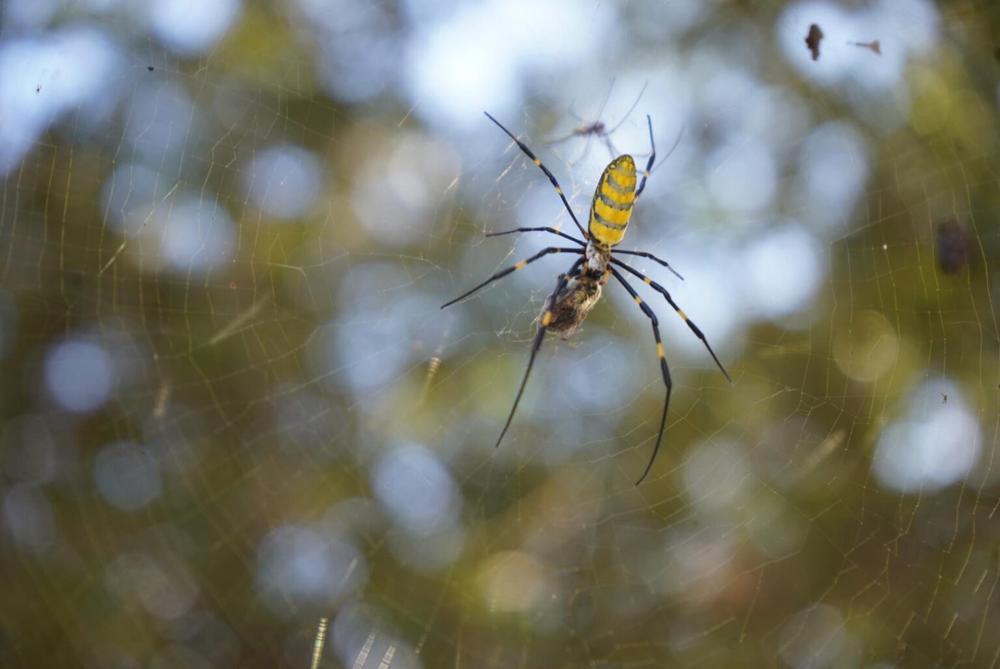
Section Branding
Header Content
Joro spiders get the publicity, but Georgia hosts armies of invasive plants and critters
Primary Content

When Kennesaw State University environmental science student Ryland McGreevy is not studying, he’s often exploring Georgia’s wild spaces, shooting photos and video for a nature-focused Instagram called Caveman Wildlife.
He’s familiar with many of Georgia’s four, six and eight-legged residents, but one large yellow spider he kept meeting during his Kennesaw outings threw him for a loop.
“I had seen this female for about two weeks in her web as it continued to grow,” he said. “My curiosity eventually made me want to identify the species, but didn’t recognize it to be the Joro spider. At first, I was a little shocked to see one where I lived, since I believed them to be more prevalent in northern Georgia.”
It’s been a bumper year for Joro spiders, a species of bright yellow orb-weaving arachnid that scientists believe hitched a ride to Georgia from its native Asia on a shipping container sometime around 2013 or 2014.
Reports of the invasive spider are up across the northern part of the state, said Richard Hoebeke, an entomologist and curator at the Georgia Museum of Natural History at the University of Georgia.
“Everybody who drops emails and images of the spider is saying they’ve not seen them as abundant in the past years as they have this year, and I’m noticing the same thing, so yeah, the Joro is doing just fine right now,” he said.
The Joro can look frightening, but unless you are a bug, it is not particularly dangerous, Hoebke said. Like all spiders, their bite can cause an allergic reaction in humans, but they are not aggressive and are more likely to flee than fight if accidentally disturbed by a person.
There has not been any data to suggest the Joro is taking food away from native spiders or otherwise upsetting the balance of the state’s ecosystems, Hoebeke said, which is good, because it looks like the little critters have found a permanent home in Georgia.
“This year, it’s very abundant, next year, it may not be so, but I think it’s here to stay,” Hoebeke said. “It’s going to become naturalized as a part of the population of orb-weaving spiders in our area.”
The best thing to do is just accept it and be thankful that as far as invasive species go, the Joro is an excellent neighbor.
“Spiders are beneficial, they are feeding on insects that a lot of people consider to be pests — yellow jackets, stink bugs, mosquitoes, other insects that people don’t want to see around the house, they would be happy to have them in their webs,” he said. “And a lot of them do end up in their webs. So I consider them beneficial, I would just simply leave them alone. Don’t get in their way. Don’t aggravate them. Just let them be.”
Other researchers say it is too soon to tell whether the introduction of this new species could have unexpected consequences in the future.
In either case, Georgia is home to a veritable rogues’ gallery of invasive critters that make the Joro spider look as harmless as a ladybug.
These creatures’ numbers are kept in check in their homelands, whether because predators there have adapted to feed on them or because the organisms they eat have developed specialized defenses. But when they come to a new place without those checks, they can spread massively, sometimes with devastating consequences.
“We already are pretty invaded by these invasive species,” said Chuck Bargeron, co-director for the Center for Invasive Species and Ecosystem Health, also known as Bugwood, at the University of Georgia. “There’s already major impacts to our lands, to our forests, to our parks, because of these species, but if we don’t all work together and recognize that invasive species is a huge environmental issue, then we’re going to lose some of our favorite tree species, some of our favorite habitats, or have significant impact on crops and other things that that would require more pesticides to be used and potentially require an increased cost because of those species.”
Georgia's least wanted
One pest with an appetite for Georgia’s trees, the emerald ash borer has a pretty green color that belies its danger. If left unchecked, this little beetle could completely wipe out entire tree populations.
“Usually within 10 years from the time the insect has been introduced to a region, it’ll essentially destroy all the ash that’s present.” Hoebeke said. “Pretty scary.”
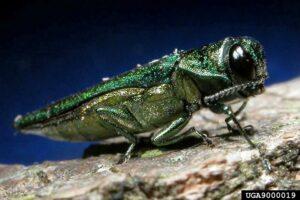
Ash is important both for animals like squirrels and birds that eat its seeds, and for humans who rely on the valuable wood these pests tunnel through.
The beetles have been found in 32 counties across north Georgia. Symptoms of infection include wilted foliage, D-shaped holes in trees and an abundance of woodpeckers or woodpecker holes — the birds love to eat the beetles’ larvae.
Another import, the aphid-like hemlock wooly adelgid is easy to identify by the egg sacs it lays underneath hemlock needles, which look like tiny cotton balls.
“Up in the northern mountains of Georgia, they have been responsible for the decline and the death of almost all of our Eastern hemlock and some of our Carolina hemlock,” Hobeke said. “This insect was introduced in the United States back in the early 1950s in Virginia, and it has since spread to between northern Georgia and coastal Maine, all the way up to Nova Scotia, so it has a pretty broad geographic range that includes especially its host Eastern hemlock. It’s a bad one.”
These bugs were first spotted in Georgia in 2003, and by 2012, they had spread across the state’s entire hemlock range, which includes 14 counties. The needles on infested trees start to turn a sickly yellowish green, and the insects can kill a healthy tree within four years.
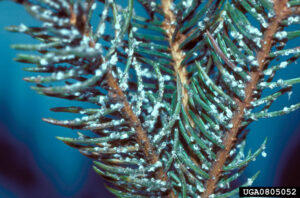
Hemlocks are vital to the ecosystems in which they grow, not only for the songbirds and other species that nest in them, but also because they help regulate the flow and temperature of streams, sheltering the aquatic life that lives beneath their shade.
The hemlock wooly adelgid rarely causes significant problems in their native continent because predatory bugs there have adapted to feed on them, keeping their numbers in check.
The Georgia Forestry Commission and partners are hoping to duplicate that effect here — they’ve released millions of predatory beetles in six areas they hope will keep the adelgids in check.
Homeowners who see the telltale white fluff on their trees should use insecticide to eradicate the pests, the forestry commission says.
But it’s not just bugs that are inadvertently being snuck into the state.
Topping the forestry commission’s list of problematic nonnative plants are privet and Nepalese browntop, also called Japanese stiltgrass, both of which grow thick and healthy in Southern soil but squeeze out native shrubs.
Because of efforts to find and eradicate them, those plants have seen their populations shrink slightly, according to a 2019 state forestry commission report. Another pesky plant, cogongrass, is no longer present in 27 of the 65 counties it was previously found in.
“Cogongrass is a huge problem in Florida, Alabama, and Mississippi,” Bargeron said. “What Georgia has been trying to do for the last 15 years is keep it from being as big a problem in Georgia as it is in those other areas. It is a major fire hazard, and it chokes out all the other vegetation when you get it established, especially under a pine stand, but even in open areas, it becomes the dominant species very quickly, so it is definitely one of the biggest problems the Forestry Commission has.”
And while insects and plant seeds are easy to accidentally transport, Georgia’s list of invasive species also includes large vertebrates like the Argentine black and white tegu, a South American lizard that can grow up to four feet long. Likely brought to Georgia as exotic pets, they’ve established breeding populations in Tatnall and Toombs counties in southeast Georgia, where they feast on bird eggs, vegetables, small animals and whatever else they can get their jaws around.
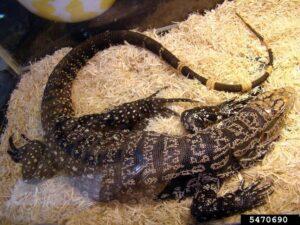
“They pretty much eat everything,” Bargeron said. “It’s just introducing something new into the ecosystem that is going to disrupt things and cause problems that way, just another large species that will eat pretty much anything.”
Invasive species can be a vector for disease as well, and while sicknesses like the West Nile virus that affect humans get the most attention, people can inadvertently import pathogens that can decimate animal populations as well. A fungus from Europe is thought to be responsible for white nose syndrome, a disease that has spread among bats across the country, including in Georgia. A 2020 report from the Georgia Department of Natural Resources found that bat numbers were down 93% at cave sites tracked by the department.
Be on the lookout
Other native species of concern that have not yet reached Georgia include the spotted lanternfly and the Asian longhorn beetle, which has destroyed millions of trees in New York, Ohio, Toronto, Chicago and New Jersey, and is knocking on Georgia’s door, Hoebeke said.
“It was just found a year ago in the suburbs of Charleston, South Carolina, and it’s actually been determined that it’s probably been there a while. Thousands of trees have been found to be infested, and all they can do in those situations is to destroy the trees and to destroy the beetle that’s within. That’s what I worry about the most here in Georgia.”
An app is available on the Bugwood website that allows users to photograph and report sightings of invasive creatures.
Bargeron said he hopes the app will allow authorities to detect and respond to threats quickly, which could be key to keeping harmful creatures away from Georgia’s trees and crops.
“It’s something that everybody can participate in, and everybody can do something,” he said. “If you’re out in nature and you see something that you’ve never seen before or you see a new plant that has all of a sudden really expanded and taken over a patch of your favorite place outside, then it’s probably worth reporting to somebody, because that may be the first time that’s been found. And if something can be done quickly to it, then we can prevent another kudzu or prevent another chestnut blight.”
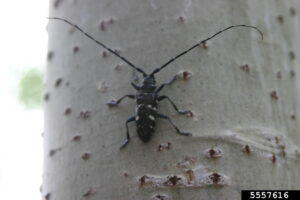
The USDA’s National Invasive Species Information Center estimates invasive species have cost North America more than $26 billion per year since 2010.
Putting an exact price tag on the damage done to Georgia crops is next to impossible, said Mark McCann, assistant dean for the University of Georgia Extension.
Their costs come not only in the form of damaged crops, but also in preventative measures.
“Sometimes we spend as much trying to mitigate or prevent as we do in the damage part, and those numbers are hard to get,” he said. “We find that in agriculture, we spend a lot on damage by disease and bugs, but we also spend a lot of money trying to prevent them.”
The most effective way to keep foreign pests from destroying Georgia’s crops or ecosystems is by stopping them from making the journey over here in the first place.
That’s where supervisory Customs and Border Patrol agriculture specialist Rebecca Rhinehart and her team come in.
Last year, more than 34 million tons of goods came to Georgia through the Port of Savannah in shipping containers, and it’s their job to get rid of any hitchhikers.
That starts with outreach to shippers about regulations — avoid storing containers outside, lest they pick up nematode-contaminated soil, make sure wood packing material has been treated for wood-boring insects and store materials at the correct temperature on the voyage so any foreign critters will freeze to death.
Once the goods arrive, Rhinehart and her crew are the ones to give the final check.
“We work pretty close with USDA, FDA, EPA, all those agencies to make sure that we’re all on the same page, we are definitely the last line of defense for the majority of the things coming in because we’re the ones physically out there doing inspections,” Rhinehart said. “It’s a fast-moving port, so we have to really be selective, we have to be smart about it, we target things. Obviously, with the amount of containers coming in there’s just not enough, you know what I mean, people, so we have to be smart and target.”
Depending on the commodity and place of origin, goods could require inspections, fumigation, cold treatment and more. Agents pay close attention to things like wood packing materials, which can house wood-boring insects or their eggs. Sometimes, to the shippers, the rules can seem overburdensome, but Rhineheart said it’s worth the effort.
“People sometimes think it’s like, arbitrary rules, but they’re all there for a reason,” she said. “It’s to protect our agriculture and sometimes, with some of the pests, you don’t see the damage. It’s not like finding narcotics or guns. It’s something that if a pest gets in, it’s small. They can establish before you even realize there’s a problem, and that could take years.”
This story comes to GPB through a reporting partnership with Georgia Recorder.

